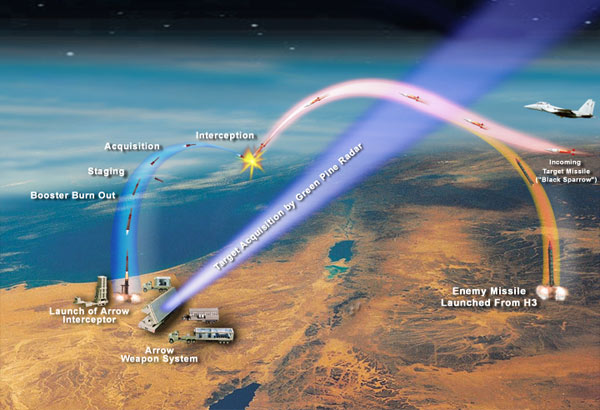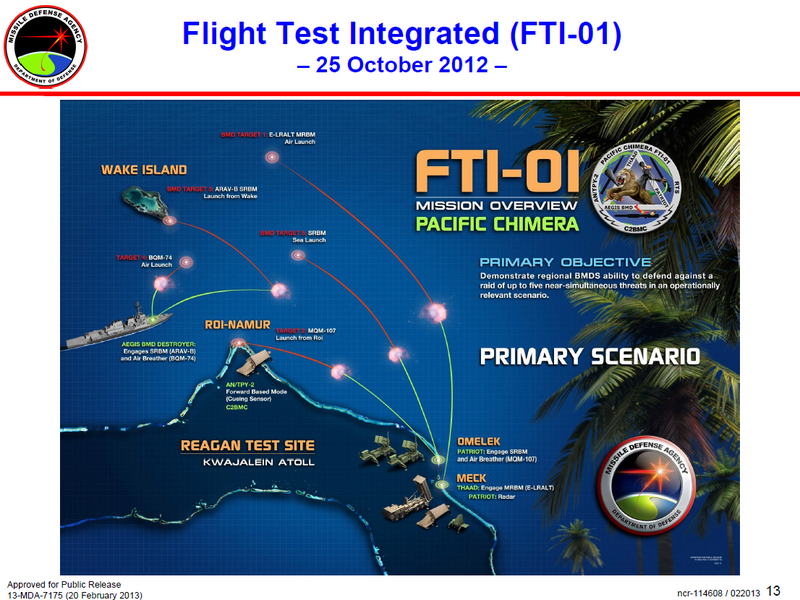brar_w wrote:The combined test? From the data that is available this was a North South engagement i.e. TBM approached from the North while the Aircraft target approached from the South. Again this is on open source data only. Keep in mind that this was a TMRR test in that they used developmental end items so was quite ambitious given where in its maturity life-cycle the product was at the time (tech. demonstrators).
Again, without specifics around elevation angles etc, this information is pretty meaningless. Its just the kind of info that is released to drum up support for the system but without getting into details of what its possible limitations are. The Russians at least released specs of the S-4XX mode wise.
What does this mean? Could you please identify which targets could fit within the system's physical limitations? The test was to validate that the system could successfully detect, track and engage a ballistic missile target and simultaneously also prosecute an air breathing target in the completely opposite direction. It did that successfully. Developmental testing is objective based and here the demonstration was to simply show that a single MEADS battery can engage off axis threats as different from each other as an aircraft and a TBM.
Physical limitations are present in all these systems. I don't know why it is so hard for you to acknowledge this. A single one panel radar cannot look up, look sideways, look at two different axis at the same time until and unless there are severe constraints placed on the kind of targets it engages. The S-400 is a dual panel PESA, in its Big Bird but Gravestone FCR is a single panel unit and that's the hard stop. An example of the above is the fact that only 1 of each kind of target was engaged. What were the engagement zones? From which angle was the TBM incoming, from what height was the aircraft coming.. the answers here are self-evident. If the MEADS used two different radars for this test, then it makes more sense and is at least more credible.
Can you please direct me to another developmental test of which you have knowledge of that did things the way you like them and how it was different?
First, see he info above and see what it shows. You will have the answers there why these hobson-jobson claims of doing everything all at once fail until and unless the system has depth to handle two entirely different classes of targets.
Karan M wrote:And this was the exact point I was making all throughout, about how the same radar cannot do both for roles.
Come on man. The same radar can do both roles within its employed sector ONLY. This was the entire reason i even brought up MEADS to state the fact that even with its expanded radar suite, it still can only do TBM in 90-120 sectors and only CMD and AAW in the 360 concurrently. To expand that employed sector, they added elements or radars.
How can you not get this? Even in the "employed sector only", and with assets added it requires two radars!! It cannot even cross beyond TBM in the 90-120 arc, and CMD/AAW in 360. Can you begin to imagine how useless it would be if it was to try and do everything without two separate optimized radars? Its employed sector would become so small as to be meaningless.
The reason why MEADS FT-2 was an important test event was because it was able to demonstrate the succesfull end to end functioning of a single battery to engage threats originating from different aspects and with different profiles. Till that time no single battery level system had done something like this though the Patriot had demonstrated concurrent TBM and Cruise missile intercept but only when the threats resided in the sector it was looking in (a key difference that I've tried to stress).
Single battery with two different radars, mind, each for a separate target class.
The Patriot (which doesn't have a rotator in its mix) can do this within its sectored coverage aginst TBM/AAW/CMD with MSE and GEM/T systems. It cannot defend against all threats in the 360 at the battery level but within the sectors it is focusing on ( can be both 90 degree or 120 degree depending on what the unit construct is) it is designed and equipped to do concurrent defense against those threat types. In fact, its main role is to protect (highly concentrated deployed troops in an Iran or North Korea scenario) from waves of raids of combined ballistic and cruise missiles hence it has the highest magazine depth of its peer group.
Again, this is just marketing literature. Fact of the matter is if there is are waves of raids (actually even a single wave) of combined ballistic, cruise and aircraft targets, the radar will struggle to cope and will need additional radars to be deployed, purely because of physical limits.
Karan M wrote:Now what's the real capability of the MEADS, its different radar modes and coverage etc?.
MEADS was a development program only, and I brought it up only to highlight the fact that even with its netted elements it too cannot do the scenario that you describe, and NO WHERE did I ever mention or claim that ANY GBAD system could. This is obviously very different from the fact that radars and C2 systems on deployed systems cannot prosecute TBMs and CMs together from the same battery over the sector they looking at. These two things are completely different which I am clearly not able to articulate in a manner that would stop us from going round and round in circles

.
Look let me make this simple.
There is no radar possible with todays technology, which is light enough (to rotate super fast, to compensate for a single panel antenna) or with the compact modules necessary to make a huge array and yet which can be hoisted up on a mast (for line of sight), which allows it to be optimized for ALL 3 sets of targets in a standard frontal sector concurrently (forget 240 degrees, even the 60 degree to each side arc for an AESA, i.e. 120 degrees).
All three classes of targets require different radar capabilities in terms of physical limits. Height coverage (mast mounted) for low flying targets, high power capability (all 3 classes of targets), extreme beam width (wider arrays te better), and then the clincher - different elevation (a radar in a missile scan setting with its antenna tilted upwards, is not going to be able to overcome the laws of physics and have its beams look downwards, which means the low flying threat is now back, and can no longer be covered).
Then there is the final aspect. Mobility. You are limited to whatever your prime mover can carry, and on top of it what your logistics can sustain. Semi-static or static systems have an advantage over the S-400s or MEADS or te Patriots of the world. This fuel issue basically means that you can forget about LRTR style high power radars. Which basically means that now, to get the high power capability, you circle back, stop rotating, and start staring at each target, sector to pick up low RCS targets.
This automatically means you give up on the aircraft threat. You are limited to the aircraft which are kind enough to pop up from where you expect the BMs to come from.
So either you prep for a BMD or a AB threat, can't do both. You can claim that you are doing both, but the scan angle coverage is so limited as to be meaningless.
Karan M wrote:Now do they need to demonstrate it against 1 TBM and 2 aircraft for it to be able to do that role?
Most certainly. Otherwise its just a very very limited POC.
I hope you realize that this is not how systems are tested either during their developmental or operational test phase. What is the maximum number of cruise missiles (forget diverse targets) the S-400 has shot down in one single flight test? Same thing with other systems..Patriot to the best of my knowledge has shot down 2-3 ballistic missiles in one single end to end to end flight test and one ballistic missile and 1 or 2 cruise missile (don't remember exactly). Does it mean these systems can't engage any more than that because those tests did not verify that? Even the maximum number of targets AEGIS has shot down in one single test is 4 but no one considers that to be the upper limits of its capability.
The entire point here is that the architecture of the system unless its "2 radar designed for" (which you added to your post later re: MEADS) will never be able to pull it off. If the architecture is designed for it, they have to scale up rapidly and demo that. A single test with 1x unit at each envelope condition (and wasn't this done several years back?) will just not be sufficient to prove the concept. Also, given the fact the Euros are involved in it.. and their whimsical cost based decisions.. less said the better about how they end up cutting down test cases.





